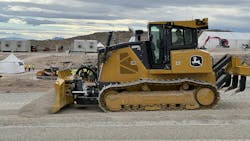What to Consider When Replacing a Dozer Blade
Dealers and distributors are an excellent source of information on wear parts and components.
H&R Equipment Parts out of Buffalo provides a handy guide on replacing crawler dozer blades.
New wear and sustained friction are the result of nearly every job a dozer does. One of the first questions for a manager to consider when thinking about any wear part is the time-honored “new or used?”
How to save on dozer operating costs
There are three choices with dozer blades: new OEM blades, new aftermarket blades, and used dozer blades, which many managers may not think of.
When researching the type of a dozer blade needed, consider the age of the machine.
Does it make sense to invest heavily in a machine that is older or might not suit your firms needs for much longer? New blades from a dealer are expensive, and it doesn't always make economic sense to take that route, H&R says.
Aftermarket dozer blades can offer an alternative to new dealer blades. However, it is important to get your blade from the right supplier.
For aftermarket dozer blades, make sure the supplier you are dealing with uses high-quality steel to ensure it can handle the conditions. The last thing you want is for blade edges or corners to be ground down after only a few jobs.
Used dozer blades?
For most situations, a used dozer blade can make sense—for the machine and the bottom line. H&R says it’s possible to find a brand of blade that was original to your machine. When searching for used blades, make sure your supplier has done a complete evaluation of the blade.
Because even a used bulldozer blade can be a big investment, H&R recommends making sure the seller has inspected and documented the state of:
- Pinholes
- Edges and corners
- Moldboards
- Blade arms
- Any included hydraulic cylinders.
Types of dozer blades
Take stock of the types of jobs upcoming and choose the blade that is best configured for those jobs.
Choices include S-blades, U-blades, S-U blades, angle blades, PAT blades, and 6-way PAT blades.
The straight, or S-blade, does not have wings. It's the shortest type, made for shaping, stripping, and fine-grading surfaces. Because it's without wings, an S-blade is not so well suited to lift and carry material. Prolonged pushes will cause material to cast off the edges.
Conversely, the U-blade is for moving large loads over distance. Large wings and a curved shape contribute to keeping loose materials contained during movement. Think production.
What did pro operators think of Develon's dozer?
The S-U blade is sort of the "middle ground," according to H&R. Small wings and a U-blade shape with less curve gives it less capacity, but increased strength.
Angle blades enable the operator to push a load on either side of the dozer. The blade is built to pivot and change alignment around a center point. It does not have wings and some of its recommended applications are for moving soil, gravel, and snow.
A PAT (power, angle, tilt) features multiple hydraulic cylinders that allow tilt and angle in nearly every direction. These are best for precision grading to exacting specifications.
The 6-way PAT adds the ability to move each side of the blade up and down independently to both the angling and the up-and-down movements of the entire blade.
Check out the guide below to visualize your choices.
About the Author
Frank Raczon
Raczon’s writing career spans nearly 25 years, including magazine publishing and public relations work with some of the industry’s major equipment manufacturers. He has won numerous awards in his career, including nods from the Construction Writers Association, the Association of Equipment Manufacturers, and BtoB magazine. He is responsible for the magazine's Buying Files.



